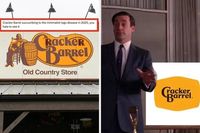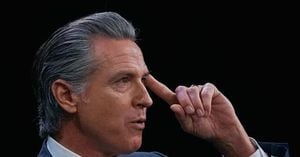Cracker Barrel, the beloved Southern-themed restaurant chain, is at the center of a heated debate after unveiling its first major logo change in nearly half a century. The move, announced in the week of August 18-21, 2025, has ignited a firestorm of reactions across the political spectrum and social media, with some customers lauding the update as a necessary step into the future and others decrying it as an unnecessary break from tradition.
For many Americans, Cracker Barrel is more than just a place to grab pancakes or browse a country store—it’s a slice of nostalgia, a place where the past feels just a little closer. The restaurant first opened its doors in 1969, sporting a simple text-only logo. But in 1977, the now-iconic image of a man resting by an oak barrel became the brand’s signature, anchoring its identity in the minds of generations of diners. That’s why, when Cracker Barrel announced it was returning to a text-based logo and dropping the familiar figure, the internet lit up like a bonfire.
According to ABC News, the new logo is part of a broader rebranding effort meant to keep the company relevant for today’s customers. The company explained in a press release that the updated design is “rooted even more closely to the iconic barrel shape and wordmark that started it all.” But for many loyalists, this explanation wasn’t enough. Social media erupted with posts ranging from confusion to outright outrage. As one user asked, “Why would they remove the cracker & the barrel?”—a question that quickly became a rallying cry among critics.
The backlash was especially fierce among MAGA-aligned media personalities and conservative commentators. Collin Rugg, a media figure with a large following, didn’t mince words, calling the new logo “depressing.” Benny Johnson, another prominent voice, warned that the change could spell disaster for the company, comparing it to what happened to other brands that embraced diversity, equity, and inclusion initiatives. “Part of the Cracker Barrel experience is feeling like you’re stepping back into an older, simpler America,” Johnson argued. “Turning that into this modern slop is bad.” He went even further, saying, “They erased the white guy sitting outside of the Cracker Barrel store. White people are about to riot.”
But the outrage wasn’t universal. In fact, many online commentators ridiculed the backlash itself. As reported by Newsweek, one user wrote, “The people freaked about Cracker Barrel changing logos are why this country is so s. Like, really out of all the issues this is what you care about? You’re f*** jokes.” Nina Turner, a former Ohio State Senator, chimed in, “People can’t afford housing, groceries, and are going bankrupt if they get cancer. So naturally, conservatives are mad about Cracker Barrel’s logo.”
Cracker Barrel CEO Julie Felss Masino, who assumed her role in July 2023 after stints at Taco Bell, Sprinkles Cupcakes, and Starbucks, has stood by the decision. Speaking on Good Morning America, Masino emphasized that the company’s goal is to balance tradition with modernity. “Cracker Barrel needs to feel like the Cracker Barrel for today and for tomorrow—the things that you love are still there. We need people to choose us, and we want people to choose us,” she said. Masino also claimed the feedback they’ve received has been “overwhelmingly positive.”
The logo change isn’t happening in a vacuum. It’s part of a larger “All the More” campaign aimed at updating the chain’s look and feel. Over the past year, Cracker Barrel has gradually revamped its in-store experience, installing new seating and lighting to create a warmer atmosphere while keeping popular features like stone fireplaces and mounted taxidermy deer heads. According to ABC News, these changes are designed to enhance the customer experience without erasing the brand’s Southern charm.
The controversy surrounding Cracker Barrel’s rebrand is hardly unique. As Hindustan Times noted, several major American brands have faced similar backlash after rebranding. Aunt Jemima became Pearl Milling Company in 2021, retiring a name and image tied to racist stereotypes—a move met with widespread resistance from longtime customers. Land O’Lakes removed the Native American woman from its packaging in 2020, prompting accusations of “erasing heritage.” Uncle Ben’s became Ben’s Original, and Dunkin’ dropped “Donuts” from its name, both sparking debates about the value of tradition versus the need to modernize.
The Cracker Barrel saga has also highlighted the increasingly polarized nature of branding decisions in the age of social media. According to Newsweek, posts criticizing the new logo have racked up millions of views, with some users even calling for CEO Masino to “face charges for this crime against humanity.” On the flip side, others see the uproar as evidence of misplaced priorities, especially given the economic and social challenges facing the country.
Amid the noise, Cracker Barrel is pressing forward. The company has enlisted country music artist Jordan Davis to star in a new commercial and host an event launching the partnership in New York on August 21, 2025. This move signals that the brand is keen to connect with both its core audience and a new generation of diners through contemporary marketing and partnerships.
Still, the question lingers: Can a brand steeped in nostalgia successfully reinvent itself without alienating its most devoted fans? For some, the answer is a resounding yes—change is necessary to survive in a fast-moving marketplace. For others, the loss of a familiar logo feels like losing a piece of personal history. As with many cultural flashpoints, the truth may lie somewhere in between.
What’s clear is that Cracker Barrel’s rebranding has tapped into deep currents of identity, memory, and the meaning of Americana. Whether the new logo will help or hinder the company’s fortunes remains to be seen, but one thing’s for sure: People are paying attention, and the conversation isn’t dying down anytime soon.






